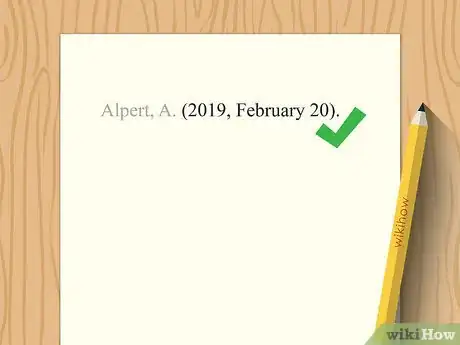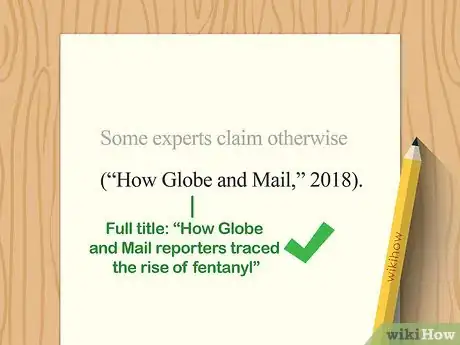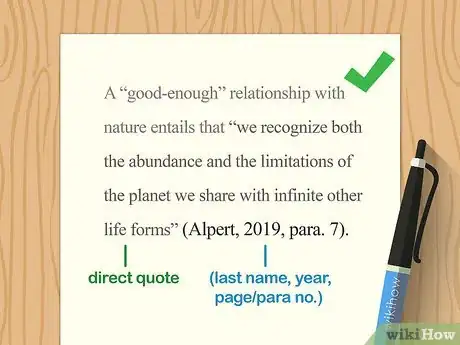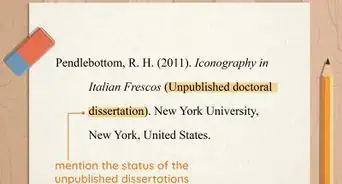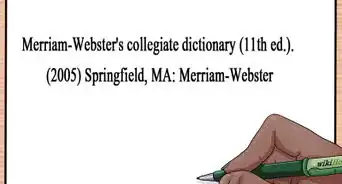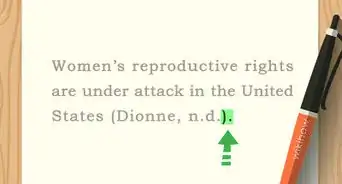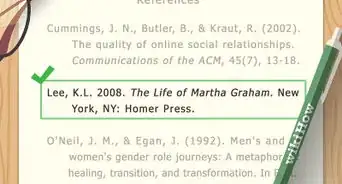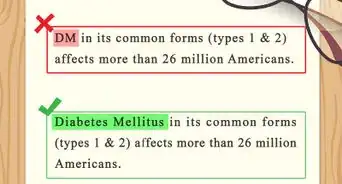This article was co-authored by wikiHow staff writer, Jennifer Mueller, JD. Jennifer Mueller is a wikiHow Content Creator. She specializes in reviewing, fact-checking, and evaluating wikiHow's content to ensure thoroughness and accuracy. Jennifer holds a JD from Indiana University Maurer School of Law in 2006.
This article has been viewed 60,855 times.
Learn more...
If you're writing a research paper, you may want to use news articles you find online as sources. When using the American Psychological Association (APA) citation method, you'll need to include both an in-text citation and an entry in the Reference List at the end of your paper. Generally, these entries should include enough information for your readers to be able to find the article you used when writing your paper. For an online news article, this means including the URL for the story in your reference list entry.[1]
Steps
Formatting Your Reference List Entry
-
1Start your entry with the last name of the author. The author of an online news article is typically listed below the headline, although it may occasionally appear at the bottom of the piece. Format the name by typing the last name first, followed by a comma, then the first initial of the author. Add a middle initial if one is provided.[2]
- Example: Alpert, A.
- If there are multiple authors, separate their names with commas, using an ampersand (&) before the last author's name.[3]
- If no individual author is listed, skip this element and start your entry with the title of the article.
-
2List the date the article was published or last updated. Look for the date of publication at the top of the article, under the headline. Place the date in parentheses, starting with the year. Place a comma after the year, then provide the month and day the article was published (if available). Do not abbreviate the month. Place a period after the closing parentheses.[4]
- Example: Alpert, A. (2019, February 20).
Advertisement -
3Type the title and subtitle of the article in sentence case. After the date of publication, type the title of the article, capitalizing only the first word and any proper nouns. If there is a subtitle, place a colon after the title and then type the subtitle, using the same capitalization. Place a period at the end.[5]
- Example: Alpert, A. (2019, February 20). The good-enough life: The desire for greatness can be an obstacle to our own potential.
-
4Add the name of the newspaper or website. After the title, type the name of the newspaper or website where you found the article in italics. Use title case, capitalizing the first word and all nouns, pronouns, adjectives, adverbs, and verbs in the name. Place a period at the end.[6]
- Example: Alpert, A. (2019, February 20). The good-enough life: The desire for greatness can be an obstacle to our own potential. The New York Times.
-
5Close with the URL for the article. After the title of the newspaper or website, type the words "Retrieved from" followed by the URL. APA recommends using the homepage of the website or newspaper in most cases, so you avoid the potential for non-working URLs. Do not place a period at the end of the URL.[7]
- Example: Alpert, A. (2019, February 20). The good-enough life: The desire for greatness can be an obstacle to our own potential. The New York Times. Retrieved from https://www.nytimes.com
Reference List Format:
Author, A.A. (Year, Month Day). Title of article in sentence case: Subtitle of article in sentence case. Title of Newspaper or Website in Title Case. Retrieved from URL
Creating In-Text Citations
-
1Include the author's name and the year of publication when paraphrasing. Generally, you need a parenthetical in-text citation at the end of any sentence in which you paraphrase information from the news article. Format your citation by typing the author's last name, followed by a comma, then the year the article was published. Place your parenthetical inside the closing punctuation of the sentence.[8]
- For example, you might write: The idea that striving for greatness might not be the best goal for humanity runs through hundreds of years of philosophy (Alpert, 2019).
Tip: APA style requires a parenthetical citation at the end of every sentence in which a source is paraphrased. The only exception would be a block quote of several sentences from the same source. In that case, your parenthetical citation would go at the end of the quote.
-
2Use the first few words of the title if the article has no author. If no individual author is credited for a news article, include the first few words of the title in your parenthetical citation, enclosed in double-quotation marks. Use title case capitalization. Place a comma inside the closing double quotation marks, then type the year the article was published.[9]
- For example, suppose one of your sources was an article from The Globe and Mail titled "How Globe and Mail reporters traced the rise of fentanyl." This article doesn't have an individual author – it is simply attributed to "staff." If you paraphrased or quoted the article in your text, your in-text citation might be: ("How Globe and Mail," 2018).
-
3Include a page or paragraph number for direct quotes. To create an in-text citation for a direct quote, direct your readers to the exact location where that material appears. For online news articles that are not paginated, count the paragraphs. Type a comma after the year of publication, then type the abbreviation "para." followed by the paragraph number.[10]
- For example, you might write: A "good-enough" relationship with nature entails that "we recognize both the abundance and the limitations of the planet we share with infinite other life forms" (Alpert, 2019, para. 7).
-
4Leave out information already provided in the body of your paper. If you include the author's name in the body of your paper, you don't need to repeat the author's name in a parenthetical citation. Instead, place the year in parentheses after the author's name. If you included both the author's name and the year of publication in the body of your paper, you don't need a parenthetical citation at all for paraphrased material.[11]
- If you name the author in the body of your paper and quote the article directly, include a parenthetical citation after the quote with the page number or paragraph where the quoted material appears.
- For articles without an individual author, a full parenthetical citation isn't necessary if you include the title of the article in the body of your paper. As with the author's name, you would simply put the year the article was published in parentheses immediately following the title of the article.
References
- ↑ https://www.apastyle.org/learn/faqs/cite-newspaper
- ↑ https://www.apastyle.org/learn/faqs/cite-newspaper
- ↑ https://bowvalleycollege.libguides.com/c.php?g=714519&p=5093747
- ↑ https://www.apastyle.org/learn/faqs/cite-newspaper
- ↑ https://owl.purdue.edu/owl/research_and_citation/apa_style/apa_formatting_and_style_guide/reference_list_electronic_sources.html
- ↑ https://owl.purdue.edu/owl/research_and_citation/apa_style/apa_formatting_and_style_guide/reference_list_electronic_sources.html
- ↑ https://owl.purdue.edu/owl/research_and_citation/apa_style/apa_formatting_and_style_guide/reference_list_electronic_sources.html
- ↑ https://columbiacollege-ca.libguides.com/apa/newspapers
- ↑ http://aus.libguides.com/apa/apa-newspaper-web

